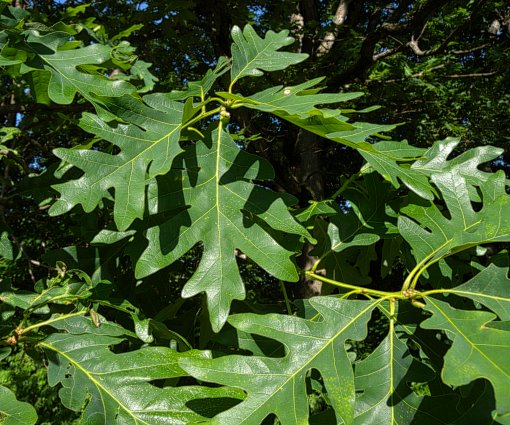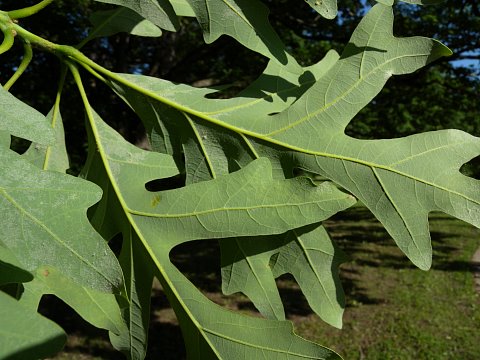 smooth, while twigs are yellowish brown to purplish brown and glabrous with scattered white lenticels (air pores). Young shoots are light green and pubescent. Alternate leaves occur along the twigs and young shoots. New leaves are pubescent, but they become hairless later. Mature leaves are 4-7" long and 2-4½" across; they are broadly elliptic or obovate in outline and pinnatifid with 3-5 pairs of deep to medium lobes. The lobes have round tips and round sinuses; sometimes a few small secondary lobes are present. The upper surface of mature leaves is medium green and glabrous, while the lower surface dull light green or gray-green and hairless (or nearly so). The leaf bases are narrow and wedge-shaped (cuneate). The petioles are ¼-¾" long, light green to yellow, and glabrous. Because of the short petioles and their stiff texture, the leaves are resistant to fluttering in the wind. Because White Oak is monoecious, separate male (staminate) and female (pistillate) flowers are produced on the same tree. Male flowers are produced in greenish yellow catkins about 2-3½" long that develop near the tips of last year's branches. Individual male flowers are 1/8" (3 mm.) across or less, consisting of an irregularly lobed calyx and several stamens. Greenish red female flowers are produced at the tips of new shoots on very short peduncles (less than 1/8" or 3 mm. long). Individual female flowers are 1/8" (3 mm.) across or less, consisting of a pubescent calyx that surrounds an ovoid ovary with 3 stigmata. The blooming period occurs from mid- to late spring for about 1-2 weeks. The flowers are cross-pollinated by the wind. Fertile female flowers are replaced by acorns that become mature by the fall. Mature acorns are ½-1" long, consisting of a shallow cap and a nut. The cap is light tan or light gray with warty scales; it extends downward to about one-fourth the length of the acorn. The nut exterior is greenish brown to light brown, ovoid in shape, and glabrous, while the meat of the nut is white and usually slightly bitter. The root system consists of a taproot and widely spreading lateral roots. The deciduous leaves become reddish purple or brown during the autumn; a few dead leaves may persist on the tree during the winter.
smooth, while twigs are yellowish brown to purplish brown and glabrous with scattered white lenticels (air pores). Young shoots are light green and pubescent. Alternate leaves occur along the twigs and young shoots. New leaves are pubescent, but they become hairless later. Mature leaves are 4-7" long and 2-4½" across; they are broadly elliptic or obovate in outline and pinnatifid with 3-5 pairs of deep to medium lobes. The lobes have round tips and round sinuses; sometimes a few small secondary lobes are present. The upper surface of mature leaves is medium green and glabrous, while the lower surface dull light green or gray-green and hairless (or nearly so). The leaf bases are narrow and wedge-shaped (cuneate). The petioles are ¼-¾" long, light green to yellow, and glabrous. Because of the short petioles and their stiff texture, the leaves are resistant to fluttering in the wind. Because White Oak is monoecious, separate male (staminate) and female (pistillate) flowers are produced on the same tree. Male flowers are produced in greenish yellow catkins about 2-3½" long that develop near the tips of last year's branches. Individual male flowers are 1/8" (3 mm.) across or less, consisting of an irregularly lobed calyx and several stamens. Greenish red female flowers are produced at the tips of new shoots on very short peduncles (less than 1/8" or 3 mm. long). Individual female flowers are 1/8" (3 mm.) across or less, consisting of a pubescent calyx that surrounds an ovoid ovary with 3 stigmata. The blooming period occurs from mid- to late spring for about 1-2 weeks. The flowers are cross-pollinated by the wind. Fertile female flowers are replaced by acorns that become mature by the fall. Mature acorns are ½-1" long, consisting of a shallow cap and a nut. The cap is light tan or light gray with warty scales; it extends downward to about one-fourth the length of the acorn. The nut exterior is greenish brown to light brown, ovoid in shape, and glabrous, while the meat of the nut is white and usually slightly bitter. The root system consists of a taproot and widely spreading lateral roots. The deciduous leaves become reddish purple or brown during the autumn; a few dead leaves may persist on the tree during the winter.
Cultivation: The preference is full or partial sun, mesic to dry-mesic conditions, and deep loamy soil. However, this oak also adapts to other kinds of soil, including those that contain silt-loam, sandy loam, clay-loam, and gravelly or rocky material. This slow-growing tree can live up to 600 years. Because of its long taproot, it is sometimes difficult to transplant. Locations prone to flooding should be avoided.
Range & Habitat: The native White Oak is a common tree that is found in every county of Illinois (see Distribution Map). It is the state tree of Illinois. Habitats include upland woodlands, well-drained areas of bottomland woodlands, sandy woodlands, bluffs, wooded slopes, savannas and sandy savannas, edges of limestone glades, and high riverbanks above the flood zone. White Oak is found in wooded areas of varying quality; sometimes it is a dominant or codominant canopy tree. White Oak is slowly being replaced by more shade tolerant trees, particularly Sugar Maple (Acer saccharum), because of the suppression of fire, to which it is moderately resistant. White Oak is also cultivated as a landscape tree and it is often found in city parks.

Faunal Associations: A large variety of insects feed on White Oak and other oak trees (Quercus spp.). This includes the larvae of metallic wood-boring beetles, larvae of long-horned beetles, leaf beetles, weevils, larvae of bark beetles, aphids, leafhoppers, treehoppers, armored scales, mealybugs, plant bugs, stink bugs, walkingsticks, larvae of gall flies, larvae of sawflies, larvae of gall wasps, and larvae of such skippers and moths as tiger moths, case-bearer moths, Geometer moths, leaf blotch miner moths, Duskywing skippers (Erynnis spp.), slug caterpillar moths, Hairstreak butterflies (Satyrium spp.), midget moths, owlet moths, prominent moths, giant silk moths, clear-winged moths, trumpet leaf-miner moths, and Tortrix moths. The Beetle Table, Aphid Table, Moth Table, and Miscellaneous Insect Table provide a more detailed list of these numerous insects. Many birds feed on the acorns of oak trees (see Bird Table). This includes ducks, crows, upland gamebirds, woodpeckers, nuthatches, and parakeets (the extinct Carolina Parakeet and non-native Monk Parakeet). Mammals that feed on acorns include the Gray Fox, White-tailed Deer, Prairie Vole, Meadow Vole, White-footed Mouse, Virginia Opossum, Raccoon, Southern Flying Squirrel, Gray Squirrel, Fox Squirrel, Red Squirrel, Eastern Chipmunk, American Black Bear, and wild hogs. White-tailed Deer also browse on the twigs and foliage, while the American Beaver eats the wood and the Cottontail Rabbit gnaws on the bark and twigs of saplings (Martin et al., 1951/1961; Whitaker, 1966; Beeman & Pelton, 1980). Many kinds of bats use White Oak and other oak trees as roost sites or sites for maternal colonies, including the Big Brown Bat, Eastern Red Bat, Little Brown Bat, Northern Long-eared Bat, Tricolored Bat, Silver-haired Bat, Evening Bat, Hoary Bat, and Indiana Bat (Perry et al., 2010; Perry & Thill, 2008; Swier, 2003; Baerwald et al., 2012; Veilleux et al., 2003; Carter, 2003). Some species of birds use these trees as nesting sites, including the Red-shouldered Hawk, Cerulean Warbler, Hooded Warbler (saplings), Blue-gray Gnatcatcher, Eastern Wood-pewee, Yellow-throated Vireo, Field Sparrow (saplings), Baltimore Oriole, Rose-breasted Grosbeak, Red-bellied Woodpecker, Red-headed Woodpecker, and American Robin (Dijak et al., 1990; Newell & Rodewald, 2011; Bielefeldt & Rosenfeld, 2001; DeGraaf, 2002; Best, 1978; Havera, 1999). Because of the huge number of insects that feed on oak trees, they attract many insectivorous birds, such as the Scarlet Tanager, Summer Tanager, Yellow-billed Cuckoo, Tufted Titmouse, Carolina Chickadee, Prothonotary Warbler, Northern Parula, Cerulean Warbler, Yellow-throated Warbler, Blue-gray Gnatcatcher, Acadian Flycatcher, Yellow-throated Vireo, and Red-eyed Vireo (Gabbe et al., 2002).

Photographic Location: Crystal Lake Park in Urbana, Illinois.
Comments: White Oak is a very impressive tree at maturity with branches of exceptional length and size. It can be distinguished from other oaks (Quercus spp.) by its light gray bark with flat scaly ridges and shallow furrows, by its moderately to deeply lobed leaves, by the relatively even size of its lobes and their rounded tips, by the pale green and hairless undersides of its leaves, and by its medium-large acorns that have shallow warty cups without fringes. The highly regarded wood of White Oak is heavy, strong, flexible, and durable. It is used to make furniture, veneer, paneling, flooring, wooden barrels (including those that store whiskey and wine), caskets, railroad ties, fence posts, mine timbers, and wooden boats. It is also an excellent source of firewood.